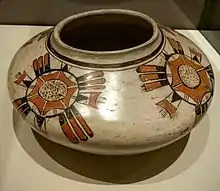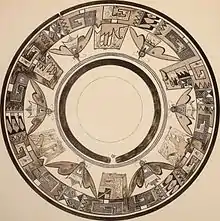Nampeyo
Nampeyo (1859 –1942)[1] was a Hopi-Tewa potter who lived on the Hopi Reservation in Arizona.[2][3] Her Tewa name was also spelled Num-pa-yu, meaning "snake that does not bite". Her name is also cited as "Nung-beh-yong," Tewa for Sand Snake.[4]
Nampeyo | |
|---|---|
Num-pa-yu (Tewa: snake that does not bite) | |
 Nampeyo, ca. 1900, photograph by A.C. Vroman | |
| Born | 1859 Hano pueblo, Arizona |
| Died | 1942 Arizona |
| Nationality | Hopi-Tewa (United States) |
| Education | Maternal grandmother |
| Known for | ceramic artist |
| Movement | Sikyátki Revival |
| Spouse(s) | Lesou (second husband) |
She used ancient techniques for making and firing pottery and used designs from "Old Hopi" pottery and sherds found at 15th-century Sikyátki ruins on First Mesa.[5] Her artwork is in collections in the United States and Europe, including many museums like the National Museum of American Art, Museum of Northern Arizona, Spurlock Museum, and the Peabody Museum of Archaeology and Ethnology at Harvard University.
A world record for Southwest American Indian pottery was declared at Bonhams Auction House in San Francisco on December 6, 2010, when one of Nampeyo's art works, a decorated ceramic pot, sold for $350,000.[6]
Early life

Nampeyo was born on First Mesa in the village of Hano, also known as Tewa Village which is primarily made up of descendants of the Tewa people from Northern New Mexico who fled west to Hopi lands about 1702 for protection from the Spanish after the Pueblo Revolt of 1680.[4] Her mother, White Corn was Tewa; her father Quootsva, from nearby Walpi, was a member of the Snake clan. According to tradition, Nampeyo was born into her mother's Tewa Corn clan. She had three older brothers, Tom Polacca, Kano, and Patuntupi, also known as Squash; Her brothers were born from about 1849 to 1858.[8][9][4] Nampeyo could not read or write and never went to school.[10]
William Henry Jackson first photographed her in 1875; she was reputedly one of the most photographed ceramic artists in the Southwest during the 1870s.[9]
About 1878[5] or 1881,[11] Nampeyo married her second husband, Lesou, a member of the Cedarwood clan at Walpi. Their first daughter, Annie, was born in 1884; William Lesso, was born about 1893; Nellie was born in 1896; Wesley in 1899; and Fannie was born in 1900.[5]
Artwork



Hopi people make ceramics painted with beautiful designs, and Nampeyo was eventually considered one of the finest Hopi potters. Nampeyo learned pottery making through the efforts of her paternal grandmother. In the 1870s, she made a steady income by selling her work at a local trading post operated by Thomas Keam.[12] By 1881 she was already known for her works of "old Hopi" pottery of Walpi.[11]
She became increasingly interested in ancient pottery form and design, recognizing them as superior to Hopi pottery produced at the time. Her second husband, Lesou (or Lesso) was reputedly employed by the archaeologist J. Walter Fewkes at the excavation of the prehistoric ruin of Sikyátki on the First Mesa of the Hano Pueblo in the 1890s. Lesou helped Nampeyo find potsherds with ancient designs which they copied onto paper and were later integrated into Nampeyo's pottery.[9][13] However, she began making copies of protohistoric pottery from the 15th through 17th centuries from ancient village sites,[5] such as Sikyátki, which was explored before Fewkes and Thomas Varker Keam.[9][11] Nampeyo developed her own style based on the traditional designs, known as Hopi Revival pottery[14] from old Hopi designs and Sikyátki pottery.[11] This is why researchers refer to her style as Sikyatki Revival after the proto-historic site.[15]
Keam hired First Mesa potters to make reproductions of the works. Nampeyo was particularly skilled. Her pottery became a success and was collected throughout the United States and in Europe.[11]
When I first began to paint, I used to go to the ancient village and pick up pieces of pottery and copy the designs. That is how I learned to paint. But now, I just close my eyes and see designs and I paint them.
— Nampeyo, 1920s[16]
Kate Cory, an artist and photographer who lived among the Hopi from 1905 to 1912 at Oraibi and Walpi,[17] wrote that Nampeyo used sheep bones in the fire, which are believed to have made the fire hot or made the pottery whiter, and smoothed the fired pots with a plant with a red blossom. Both techniques are ancient Tewa pottery practices.[18] Nampeyo used up to five different clays in one creation when the usual was two.[19]
Nampeyo and her husband traveled to Chicago in 1898 to exhibit her pottery. Between 1905 and 1907, she produced and sold pottery out of a pueblo-like structure called Hopi House, a tourist attraction (combination of museum, curio shop, theatre, and living space for Native American dancers and artists) at the Grand Canyon lodge, operated by the Fred Harvey Company.[5][11] She exhibited in 1910 at the Chicago United States Land and Irrigation Exposition.[5][16]
One of her famous patterns, the migration pattern, represented the migration of the Hopi people, with feather and bird-claw motifs. An example is a 1930s vase in the collection of the Smithsonian Institution's National Museum of the American Indian in Washington, D.C.[16] Her work is distinguished by the shapes of the pottery and the designs. She made wide, low, rounded, shaped pottery and, in later years, tall jars.[9] Many of her works are identifiable by her "recognizable designs" and "her artistic idiosyncrasies."[4]
Nampeyo's photograph was often used on travel brochures for the American southwest.[21]
Nampeyo began to lose her sight due to trachoma about the turn of the 20th-century.[21][22] From 1925 until her death she made pottery by touch and they were then painted by her husband, daughters or other family members.[23]
In 2010, one of her artworks, a pot with a bulbous form with Hopi Kachina figures with "stylized faces" wearing "flamboyant black and burnt-umber headdresses" painted on "four sides of the pot"—sold for $350,000. Previous owners included Carter Harrison Jr. who was mayor of Chicago from 1911–1915, and Chicago's Cliff Dwellers art club, who received the work from Harrison in the 1930s.[6]
Death and legacy

She died in 1942 at the home of her son Wesley and her daughter-in-law, Cecilia.[5]
She was a symbol of the Hopi people and was a leader in the revival of ancient pottery. She inspired dozens of family members over several generations to make pottery, including daughters Fannie Nampeyo and Annie Healing.[9][22]A 2014 exhibit at the Museum of Northern Arizona presents the works of four generations of artists descended from Nampeyo.[24]
Public collections
%252C_early_1900s%252C_Heard_Museum.JPG.webp)
- Arizona State Museum, University of Arizona[25]
- Denver Art Museum, Colorado[26]
- Kansas City Museum, Kansas City, MO[27]
- Koshare Indian Museum, La Junta, CA[28]
- Millicent Rogers Museum, Taos, NM[29]
- Museum of Northern Arizona, Flagstaff, AZ[24]
- National Museum of the American Indian, Smithsonian Institution, Washington, DC[16]
- Peabody Museum of Archaeology and Ethnology, Harvard University, Cambridge, MA[11]
- Union Station, Kansas City, MO[27]
- Museum of Indian Arts and Culture/Laboratory of Anthropology, Santa Fe, NM[30]
- Haffenreffer Museum of Anthropology at Brown University, Providence, RI [31]
See also
- Fannie Nampeyo, daughter
- Daisy Hooee, granddaughter
- Elva Nampeyo, granddaughter
- Dextra Nampeyo Quotskuyva, great-granddaughter
- Priscilla Namingha, great-granddaughter
- Dan Namingha, great-great grandson
- Ida Sahmie, great-great daughter-in-law
- Nampeyo (crater), named to honor Nampeyo
References
- "Infinity of Nations: Southwest". National Museum of the American Indian. Smithsonian Institution. Retrieved 8 June 2016.
- Dillingham, Rick. Fourteen Families in Pueblo Pottery. Albuquerque: University of New Mexico Press, 1994. ISBN 0-8263-1499-6. pp. 14-15
- Various sources give 1856 or 1860 as Nampeyo's birthdate.
- Kramer, Barbara, 1926- (1996). Nampeyo and her pottery (1st ed.). Albuquerque: University of New Mexico Press. pp. 6, 8, 164, 194. ISBN 0-585-36572-5. OCLC 47010594.CS1 maint: multiple names: authors list (link)
- A Nampeyo Timeline Archived 2008-02-08 at the Wayback Machine, Arizona State Museum at the University of Arizona. Retrieved April 7, 2014.
- Loomis, Brandon (December 27, 2010). "Raid drives down demand for American Indian artifacts". The Salt Lake Tribune. San Francisco. Retrieved September 21, 2017.
- Barbara Kramer. Nampeyo and Her Pottery. University of Arizona Press; 1 February 2003. ISBN 978-0-8165-2321-4. p. 20.
- Barbara Kramer. Nampeyo and Her Pottery. University of Arizona Press; 1 February 2003. ISBN 978-0-8165-2321-4. p. xi, 7, 194.
- Diane Dittemore. "The Nampeyo Legacy: A Family of Hopi-Tewa Potters". Southwest Art. Retrieved April 9, 2014.
- Peterson, Susan, 1925-2009. (1997). Pottery by American Indian women : the legacy of generations. National Museum of Women in the Arts (U.S.), Heard Museum. (1st ed.). New York: Abbeville Press. p. 55. ISBN 0-7892-0353-7. OCLC 36648903.CS1 maint: multiple names: authors list (link)
- Lea S. McChesney. "Producing 'Generations in Clay'". Expedition Magazine. Penn Museum. March 1994. Retrieved April 7. 2014.
- Wade Edwin L., Lea S. McChesney and Thomas Keam. "Historic Hopi Ceramics: The Thomas V. Keam Collection of the Peabody Museum of Archaeology and Ethnology".
- Barbara Kramer. Nampeyo and Her Pottery. University of Arizona Press; 1 February 2003. ISBN 978-0-8165-2321-4. pp. 118–120.
- Barbara Kramer. Nampeyo and Her Pottery. University of Arizona Press; 1 February 2003. ISBN 978-0-8165-2321-4. pp. 143, 160.
- Dittemore D. The Nampeyo legacy. Southwest Art [serial online]. August 2001;31(3):175-183. Available from: OmniFile Full Text Select (H.W. Wilson), Ipswich, MA. Accessed December 5, 2015.
- Les Namingha. Nampeyo. National Museum of the American Indian, Smithsonian Institution. Retrieved April 7, 2014.
- Opitz, Glenn B., Mantle Fielding's Dictionary of American Painters, Sculptors & Engravers, Apollo Books, Poughkeepsie, NY, 1988
- Barbara Kramer. Nampeyo and Her Pottery. University of Arizona Press; 1 February 2003. ISBN 978-0-8165-2321-4. p. 73–74.
- Blair, Mary Ellen. (1999). The legacy of a master potter : Nampeyo and her descendants. Blair, Laurence R. Tucson: Treasure Chest Books. p. 65. ISBN 1-887896-06-6. OCLC 41666705.
- Barbara Kramer. Nampeyo and Her Pottery. University of Arizona Press; 1 February 2003. ISBN 978-0-8165-2321-4. p. 70.
- Peterson, Susan; National Museum of Women in the Arts (U.S.); Heard Museum (1997). Pottery by American Indian women: the legacy of generations. New York: Abbeville Press. p. 57. ISBN 978-0-7892-0353-3. OCLC 36648903.
- Appendix D: Ranking 'Nampeyo Pots'. Archived 2011-06-30 at the Wayback Machine Native American Art Collection. http://www.firstpeoplepots.com Retrieved April 9, 2013.
- Betsey Bruner. "A Family Connection: New MNA Exhibit Focuses on Family Legacy" Arizona Daily Sun. November 10, 2013. Retrieved April 7, 2014.
- A Nampeyo Showcase Archived 2015-09-24 at the Wayback Machine. Arizona State Museum, University of Arizona. Retrieved April 7, 2014.
- Nameyo: Excellence by Name Archived 2014-04-09 at the Wayback Machine. Denver Art Museum. Retrieved April 7, 2014.
- "Pueblo Pottery Exhibit Opens at McClung Museum September 7". Tennessee Today. University of Tennessee. August 29, 2013. Retrieved April 9, 2014.
- Museum Artists. Archived 2008-05-18 at the Wayback Machine Koshare Indian Museum. Retrieved April 7, 2014.
- "Taos museum acquires Nampeyo pottery vessel". The Taos News. June 20, 2013. Retrieved April 7, 2014.
- "Untitled Hopi Jar, {{abbr|ca.|circa}} 1900". Archived from the original on 2014-04-23. Retrieved 2014-04-21.
- https://www.brown.edu/research/facilities/haffenreffer-museum/collections
Further reading
- Elmore, Steve. 2015. In Search of Nampeyo, Santa Fe, Spirit Bird Press and Steve Elmore Indian Art.
- Blair, Mary Ellen; Blair, Laurence R. (1999). The Legacy of a Master Potter: Nampeyo and Her Descendants. Tucson: Treasure Chest Books. ISBN 1-887896-06-6. OCLC 41666705.
- Graves, Laura. Thomas Varker Keam, Indian Trader. Norman: University of Oklahoma Press, 1998. ISBN 0-8061-3013-X.
- Collins, John E. Nampeyo, Hopi Potter: Her Artistry and Her Legacy. Fullerton CA: Muckenthaler Cultural Center. 1974
- Rubenstein, Charlotte Streifer. American Women Artists: From Early Indian Times to the Present. NEw York: Avon, 1982.
External links
| Wikimedia Commons has media related to Nampeyo. |
- Photographic Resources Guide to the North American Collection, Thomas Keam's Southwest Expedition
- Nampeyo - Hopi master potter